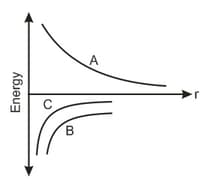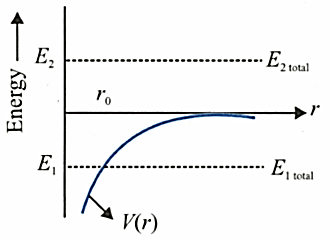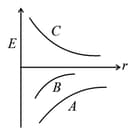Energy of an Orbiting Satellite
Energy of an Orbiting Satellite: Overview
This topic covers concepts such as Gravitational Potential Energy of Satellites, Kinetic Energy of Satellites, and Conservation of Total Energy in Satellites.
Important Questions on Energy of an Orbiting Satellite

The figure shows the variation of energy with the orbit radius of a body in circular planetary motion. Find the correct statement about the curves A, B and C
Two satellites and have masses and respectively. is in a circular orbit of radius and is in a circular orbit of radius around the earth. The ratio of their kinetic energies, is
For a satellite orbiting very close to earth's surface, total energy is
An artificial satellite moving in a circular orbit around the earth has a total () energy . Its potential energy and kinetic energy respectively are
What is the minimum energy required to launch a satellite of mass from the surface of a planet of mass and in a circular orbit with an altitude of ?
A satellite is moved from one circular orbit around the earth, to another orbit of lesser radius. Which of the following statements is true ?
Suppose earth's orbital motion around the sun is suddenly stopped. Find the time (in days) taken by the earth to fall into the sun.
The satellites when launched from the earth are not given an orbital velocity initially. A multi-stage rocket propeller carries the spacecraft up to its orbit and during each stage rocket has been fired to increase the velocity to acquire the desired velocity for a particular orbit. The last stage of the rocket brings the satellite in circular/elliptical (desired) orbit. Consider a satellite of mass 150 kg in a low circular orbit. In this orbit, we cannot neglect the effect of air drag. This air opposes the motion of satellite and hence the total mechanical energy of earth-satellite system decreases. That means the total energy becomes more negative and hence the orbital radius decreases which causes the increase in kinetic energy. When the satellite comes in the low energy orbit, excessive thermal energy generation due to air friction may cause the satellite to burn up. Based on the above information, answer the following question.
If due to air drag, the orbital radius of the earth decreases from to . Then, the change in is:
The satellites when launched from the earth are not given an orbital velocity initially. A multi-stage rocket propeller carries the spacecraft up to its orbit and during each stage rocket has been fired to increase the velocity to acquire the desired velocity for a particular orbit. The last stage of the rocket brings the satellite in circular/elliptical (desired) orbit. Consider a satellite of mass 150 kg in a low circular orbit. In this orbit, we cannot neglect the effect of air drag. This air opposes the motion of satellite and hence the total mechanical energy of earth-satellite system decreases. That means the total energy becomes more negative and hence the orbital radius decreases which causes the increase in kinetic energy. When the satellite comes in the low energy orbit, excessive thermal energy generation due to air friction may cause the satellite to burn up. Based on the above information, answer the following question.
If due to air drag, the orbital radius of the earth decreases from to . Then, the change in kinetic energy is:
The satellites when launched from the earth are not given an orbital velocity initially. A multi-stage rocket propeller carries the spacecraft up to its orbit and during each stage rocket has been fired to increase the velocity to acquire the desired velocity for a particular orbit. The last stage of the rocket brings the satellite in circular/elliptical (desired) orbit. Consider a satellite of mass 150 kg in a low circular orbit. In this orbit, we cannot neglect the effect of air drag. This air opposes the motion of satellite and hence the total mechanical energy of earth-satellite system decreases. That means the total energy becomes more negative and hence the orbital radius decreases which causes the increase in kinetic energy. When the satellite comes in the low energy orbit, excessive thermal energy generation due to air friction may cause the satellite to burn up. Based on the above information, answer the following question.
It has been mentioned in the passage that as decreases, decreases but increases. The increase in is: [ total mechanical energy, orbital radius, kinetic energy]
In the graph shown, the potential energy of the earth-satellite system is shown by a solid line as a function of distance (the separation between the earth's centre and satellite). The total energy of the two objects which may or may not be bounded to the earth is shown in the figure by dotted lines. Mark the correct statement(s).

An artificial satellite moving in a circular orbit around the earth has a total (kinetic + potential) energy , its potential energy is
A satellite has kinetic energy potential energy and total energy . Which of the following statement is true?
Satellite has mass and orbital radius Satellite has mass and orbital radius The ratio of kinetic energy of satellite and will be:
Speed of a satellite is in its circular orbit. What is the kinetic energy of mass which is ejected from satellite so that it escape from gravitational field of Earth.
is energy required to take a satellite up to height from surface of earth. is kinetic energy required to perform circular motion at that height if then will be [Radius of earth ]
A body is thrown from the surface of earth with velocity at some angle from the vertical. If the maximum height reached by the body is . Then choose the correct option(s): ( radius of earth)
A satellite of mass revolves around the earth with a velocity . The total energy of the satellite is:
A body of mass is moved to a height equal to the radius of the earth. The increase in potential energy is
An artificial satellite is made to move in circular orbits of different radii around the earth. The variations of its K.E., P.E. and total energy () in different orbits is shown in the figure by different curves.
Then for the satellites

